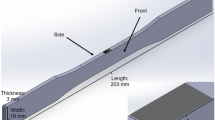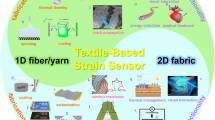Abstract
The increasing use of composite materials in various industries has evidenced the need for development of more effective nondestructive evaluation methodologies in order to reduce rejected parts and to optimize production cost. Infrared thermography is a noncontact, fast and reliable non-destructive evaluation technique that has received vast and growing attention for diagnostic and monitoring in the recent years. This paper describes the quantitative analysis of artificial defects in Glass fiber reinforced plastic plate by using Lockin infrared thermography. The experimental analysis was performed at several excitation frequencies to investigate the sample ranging from 2.946 Hz down to 0.019 Hz and the effects of each excitation frequency on defect detachability. The four point method was used in post processing of every pixel of thermal images using the MATLAB programming language. The relationship between the phase contrast with defects depth and area was examined. Finally, phase contrast method was used to calculate the defects depth considering the thermal diffusivity of the material being inspected and the excitation frequency for which the defect becomes visible. The obtained results demonstrated the effectiveness of Lock-in infrared thermography as a powerful measurement technique for the inspection of Glass fiber reinforced plastic structures.
Similar content being viewed by others
References
R. S. Ghiass, Y. Duan, K. Peycheva and X. Maldague, Inspection of glass fiber reinforced plastic (GFRP) using near/shortwave infrared and ultrasound/optical excitation thermography, Proceeding of CANSMART International Workshop on Smart materials & Structures and NDT in Aerospace in Conjunction with the NDT in Canada 2011 Conference (2011).
C. Meola and G. M. Carlomagno, Impact damage in GFRP: new insights with infrared thermography, Composites Part A: Applied Science and Manufacturing, 41 (12) (2010) 1839–1847.
C. Meola and G. M. Carlomagno, Infrared thermography to evaluate impact damage in glass/epoxy with manufacturing defects, International Journal of Impact Engineering, 67 (2014) 1–11.
G. Kim, S. Hong, G. H. Kim and K. Jhang, Evaluation of subsurface defects in fiber glass composite plate using lockin technique, International Journal of Precision Engineering and Manufacturing, 13 (4) (2012) 465–470.
C. Meola and G. M. Carlomagno, Lock-in thermography to detect delamination in carbon fibres reinforced polymers, Springer (2015) 263–279.
R. Montanini and F. Freni, Non-destructive evaluation of thick glass fiber-reinforced composites by means of optically excited lock-in thermography, Composites Part A: Applied Science and Manufacturing, 43 (11) (2012) 2075–2082.
Y. Duan, P. Servais, M. Genest, C. Ibarra-Castanedo and X. P. Maldague, ThermoPoD: A reliability study on active infrared thermography for the inspection of composite materials, Journal of Mechanical Science and Technology, 26 (7) (2012) 1985–1991.
B. Yang, Y. Huang and L. Cheng, Defect detection and evaluation of ultrasonic infrared thermography for aerospace CFRP composites, Infrared Physics & Technology, 60 (2013) 166–173.
H. Fazeli and M. Mirzaei, Shape identification problems on detecting of defects in a solid body using inverse heat conduction approach, Journal of Mechanical Science and Technology, 26 (11) (2012) 3681–3690.
L. Junyan, L. Liqiang and W. Yang, Experimental study on active infrared thermography as a NDI tool for carbon–carbon composites, Composites Part B: Engineering, 45 (1) (2013) 138–147.
H. Czichos, Handbook of technical diagnostics: Fundamentals and application to structures and systems, Springer Science & Business Media (2013).
K. K. Ghosh and V. M. Karbhari, Use of thermography as a NDE tool for detecting damage in FRP rehabilitated concrete structures, Proceedings of the Joint American Society for Composites/American Society for Testing and Materials Committee D30 Nineteenth Technical Conference (2004).
C. Meola and G. M. Carlomagno, Recent advances in the use of infrared thermography, Measurement Science and Technology, 15 (9) (2004) R27.
X. Maldague and P. Moore, Infrared and thermal testing nondestructive testing handbook, Vol. 3, American Society for Nondestructive Testing (2001).
X. Maldague, Theory and practice of infrared technology for nondestructive testing (2001).
V. Vavilov, Infrared techniques for materials analysis and nondestructive testing, Infrared Methodology and Technology (1994) 230–309.
B. Lahiri, S. Bagavathiappan, P. Reshmi, J. Philip, T. Jayakumar and B. Raj, Quantification of defects in composites and rubber materials using active thermography, Infrared Physics & Technology, 55 (2) (2012) 191–199.
K. Chatterjee, S. Tuli, S. G. Pickering and D. P. Almond, A comparison of the pulsed, lock-in and frequency modulated thermography nondestructive evaluation techniques, NDT & E International, 44 (7) (2011) 655–667.
L. Junyan, T. Qingju, L. Xun and W. Yang, Research on the quantitative analysis of subsurface defects for nondestructive testing by lock-in thermography, NDT & E International, 45 (1) (2012) 104–110.
R. Thomas, J. Pouch, Y. Wong, L. Favro, P. Kuo and A. Rosencwaig, Subsurface flaw detection in metals by photoacoustic microscopya, Journal of Applied Physics, 51 (2) (1980) 1152–1156.
Author information
Authors and Affiliations
Corresponding author
Additional information
Ranjit Shrestha is a Ph.D. candidate in Thermal design and infrared laboratory of Kongju National University, Cheonan, Korea. His main research interests include non-destructive testing, infrared thermography, machine vision, image processing, fault diagnosis, modeling & simulation and renewable energy technologies.
Wontae Kim is a professor at Division of Mechanical & Automotive Engineering, Kongju national university, Cheonan, Korea. As a research professor, he has contributed to several publications in the field of infrared imaging. His research interests are focused in nondestructive testing, infrared thermography, energy saving, heat transfer and fluid mechanics.
Rights and permissions
About this article
Cite this article
Ranjit, S., Choi, M. & Kim, W. Quantification of defects depth in glass fiber reinforced plastic plate by infrared lock-in thermography. J Mech Sci Technol 30, 1111–1118 (2016). https://doi.org/10.1007/s12206-016-0215-5
Received:
Revised:
Accepted:
Published:
Issue Date:
DOI: https://doi.org/10.1007/s12206-016-0215-5




